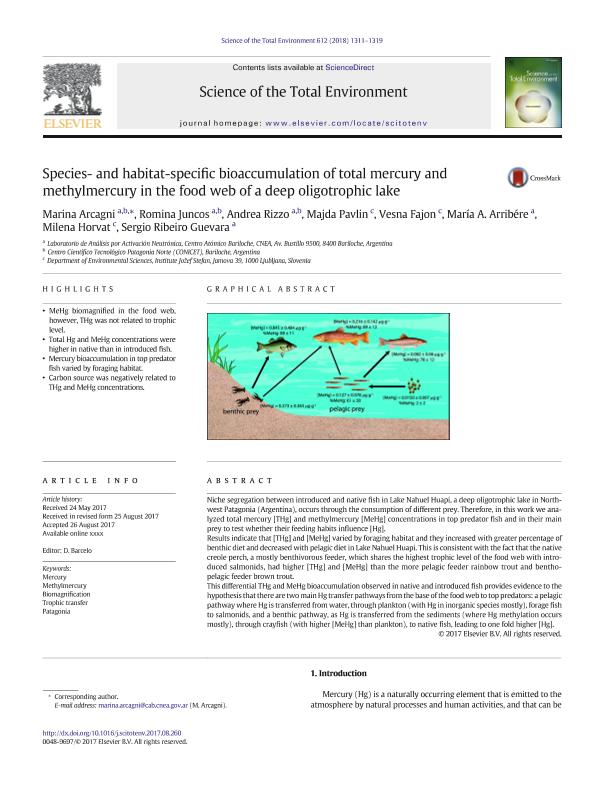Artículo
Species- and habitat-specific bioaccumulation of total mercury and methylmercury in the food web of a deep oligotrophic lake
Arcagni, Marina ; Juncos, Romina
; Juncos, Romina ; Rizzo, Andrea Paula
; Rizzo, Andrea Paula ; Pavlin, Majda; Fajon, Vesna; Arribére, María Angélica; Horvat, Milena; Ribeiro Guevara, Sergio
; Pavlin, Majda; Fajon, Vesna; Arribére, María Angélica; Horvat, Milena; Ribeiro Guevara, Sergio
 ; Juncos, Romina
; Juncos, Romina ; Rizzo, Andrea Paula
; Rizzo, Andrea Paula ; Pavlin, Majda; Fajon, Vesna; Arribére, María Angélica; Horvat, Milena; Ribeiro Guevara, Sergio
; Pavlin, Majda; Fajon, Vesna; Arribére, María Angélica; Horvat, Milena; Ribeiro Guevara, Sergio
Fecha de publicación:
15/01/2018
Editorial:
Elsevier
Revista:
Science of the Total Environment
ISSN:
0048-9697
Idioma:
Inglés
Tipo de recurso:
Artículo publicado
Clasificación temática:
Resumen
Niche segregation between introduced and native fish in Lake Nahuel Huapi, a deep oligotrophic lake in Northwest Patagonia (Argentina), occurs through the consumption of different prey. Therefore, in this work we analyzed total mercury [THg] and methylmercury [MeHg] concentrations in top predator fish and in their main prey to test whether their feeding habits influence [Hg]. Results indicate that [THg] and [MeHg] varied by foraging habitat and they increased with greater percentage of benthic diet and decreased with pelagic diet in Lake Nahuel Huapi. This is consistent with the fact that the native creole perch, a mostly benthivorous feeder, which shares the highest trophic level of the food web with introduced salmonids, had higher [THg] and [MeHg] than the more pelagic feeder rainbow trout and bentho-pelagic feeder brown trout. This differential THg and MeHg bioaccumulation observed in native and introduced fish provides evidence to the hypothesis that there are two main Hg transfer pathways from the base of the food web to top predators: a pelagic pathway where Hg is transferred from water, through plankton (with Hg in inorganic species mostly), forage fish to salmonids, and a benthic pathway, as Hg is transferred from the sediments (where Hg methylation occurs mostly), through crayfish (with higher [MeHg] than plankton), to native fish, leading to one fold higher [Hg].
Palabras clave:
BIOMAGNIFICATION
,
MERCURY
,
METHYLMERCURY
,
PATAGONIA
,
TROPHIC TRANSFER
Archivos asociados
Licencia
Identificadores
Colecciones
Articulos(CCT - PATAGONIA NORTE)
Articulos de CTRO.CIENTIFICO TECNOL.CONICET - PATAGONIA NORTE
Articulos de CTRO.CIENTIFICO TECNOL.CONICET - PATAGONIA NORTE
Citación
Arcagni, Marina; Juncos, Romina; Rizzo, Andrea Paula; Pavlin, Majda; Fajon, Vesna; et al.; Species- and habitat-specific bioaccumulation of total mercury and methylmercury in the food web of a deep oligotrophic lake; Elsevier; Science of the Total Environment; 612; 15-1-2018; 1311-1319
Compartir
Altmétricas



